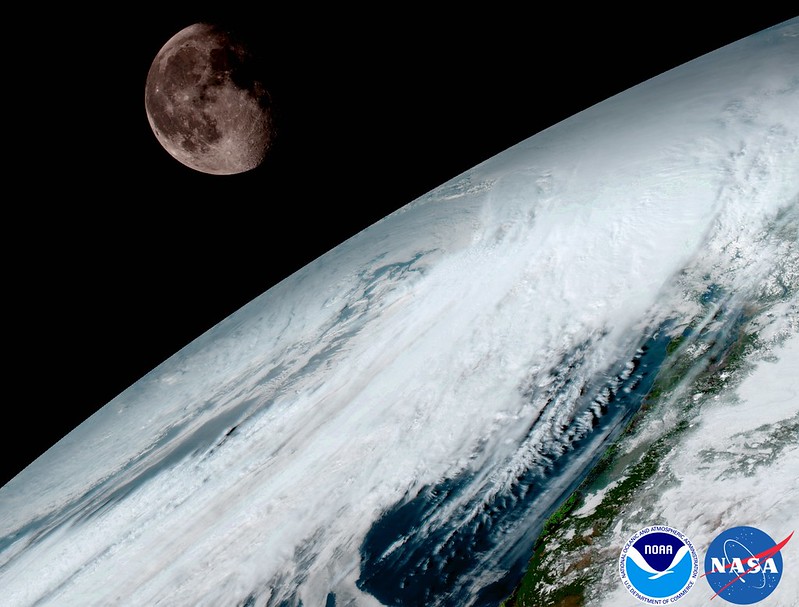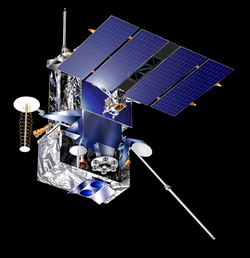|
Tag Archives: goes
NOAA releases first images from new GOES satellite

NOAA released the first images from their new GOES-16 satellite and to say they are stunning would be an understatement. The new satellite, built in Colorado by Lockheed Martin, contains some of the highest resolution cameras and most advanced sensors in the world.
From NOAA:
Since the GOES-16 satellite lifted off from Cape Canaveral on November 19, scientists, meteorologists and ordinary weather enthusiasts have anxiously waited for the first photos from NOAA’s newest weather satellite, GOES-16, formerly GOES-R.
The release of the first images today is the latest step in a new age of weather satellites. It will be like high-definition from the heavens.
- Scroll down to view all of the new images released by NOAA
The pictures from its Advanced Baseline Imager (ABI) instrument, built by Harris Corporation, show a full-disc view of the Western Hemisphere in high detail — at four times the image resolution of existing GOES spacecraft. The higher resolution will allow forecasters to pinpoint the location of severe weather with greater accuracy. GOES-16 can provide a full image of Earth every 15 minutes and one of the continental U.S. every five minutes, and scans the Earth at five times the speed of NOAA’s current GOES imagers.
NOAA’s GOES-16, situated in geostationary orbit 22,300 miles above Earth, will boost the nation’s weather observation network and NOAA’s prediction capabilities, leading to more accurate and timely forecasts, watches and warnings.
“This is such an exciting day for NOAA! One of our GOES-16 scientists compared this to seeing a newborn baby’s first pictures — it’s that exciting for us,” said Stephen Volz Ph.D. director of NOAA’s Satellite and Information Service. “These images come from the most sophisticated technology ever flown in space to predict severe weather on Earth. The fantastically rich images provide us with our first glimpse of the impact GOES-16 will have on developing life-saving forecasts.”
In May, NOAA will announce the planned location for GOES-16. By November 2017, GOES-16 will be operational as either GOES-East or GOES-West. Once operational, NOAA will use the satellite’s six new instruments to generate new or improved meteorological, solar, and space weather products.
Second satellite in GOES series already in development
Following on the heels of GOES-R will be, GOES-S, the second of four spacecraft in the series. GOES-S is undergoing environmental testing at Lockheed Martin’s Corporation facility in Littleton, Colorado, where it was built. A full set of environmental, mechanical and electromagnetic testing will take about one year to complete. The GOES-S satellite will be moved into the other operational position as GOES-17 immediately after launch and initial checkout of the satellite, approximately nine months after GOES-16.
| [flickr_set id=”72157679494723805″] |
Next generation weather satellite to be built in Denver

The National Oceanic and Atmospheric Administration (NOAA) has selected Lockheed Martin Space Systems Company of Denver to build their next generation of weather and environment monitoring satellites. When the GOES-R satellites are launched in 2015, they will provide unprecedented capability to NOAA, the National Weather Service and all weather forecasters through the use of advanced technology.
These extraordinary satellites will provide everything from lightning mapping and improved hurricane forecasting to monitoring of sea surface temperatures. The press release from NOAA provides some of the details on this exciting endeavor:
NOAA, NASA Select Contractor to Build GOES-R Series Spacecraft
New Geostationary Satellites Will Give Forecasters Better Information
December 2, 2008
NOAA and NASA officials announced today Lockheed Martin Space Systems Company, of Denver, Colo., has been selected to build two spacecraft for NOAA’s next generation geostationary satellite series, GOES-R. There are two options, each providing for one additional satellite. Scheduled for launch in 2015, the new satellites will provide more data in greater detail which is essential to creating accurate weather forecasts.
The contract has a total value of $1.09 billion for the two satellites. A separate contract to build the GOES-R ground system, which receives, processes and distributes data transmitted from the spacecraft, will be announced later in 2009, officials said.
“GOES-R, with its highly advanced instruments and sensors, will provide about 50 times more weather and climate data than is available with NOAA’s current fleet of geostationary satellites,” said Mary Kicza, assistant administrator for NOAA Satellite and Information Service. “The American public will see real life-saving benefits from this satellite system with more timely forecasts and warnings for severe weather.”
GOES-R will improve the monitoring of sea surface temperatures and also provide more data to hurricane forecasters by giving sharper images of storms every 30 seconds, instead of every 7.5 minutes as the current satellites provide.
Additionally, GOES-R will carry a first-of-its-kind instrument called the Geostationary Lightning Mapper, which will quickly locate all lightning flashes occurring anytime, anywhere in the Western Hemisphere. The lightning mapper will aid in predicting tornadoes, which often spawn from lightning-packed thunderstorms.
Other key benefits expected from GOES-R include: greater monitoring of surface temperatures in metropolitan areas to improve warnings for heat stress, and better data to bolster the forecasts for unhealthy air quality days. GOES-R will feature advanced solar monitoring instruments for space weather forecasts and warnings of solar storms. These storms endanger billions of dollars worth of commercial and government assets in space and cause power surges for the satellite-based electronics and communications industry.
George Morrow, director of Flight Project for NASA’s Goddard Space Flight Center in Greenbelt, Md. said, “NASA Goddard is excited to be NOAA’s partner in this next generation GOES development and we look forward to delivering an outstanding observatory for their operational use.”
NOAA funds, manages and will operate the GOES-R program. NASA’s Goddard Space Flight Center oversees the acquisition of the GOES-R spacecraft and instruments for NOAA.
For more information: NOAA / NASA GOES-R website
